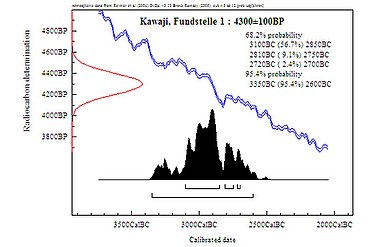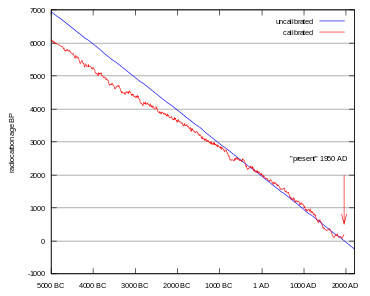Before Present
English Before Present ( BP ) is an indication of the reference point for age information based on radiocarbon dating . Contrary to the meaning of the word before today , it is not an absolute indication based on the current point in time, but was defined in technical terms as " before 1950 ", which regularly leads to problems of understanding among laypeople.
The radiocarbon method ( 14 C data ) gives the absolute age of a sample at the time of analysis in uncalibrated radiocarbon years. For practical reasons, the data are converted to a defined basis, the year 1950. Because the carbon years are not identical to calendar years, they must be calibrated . An age specification BP without further information describes uncalibrated 14 C data, the calibrated data are technically referred to as cal BP .
The 1950s choice is explained by the practical exploitation of radiocarbon dating in the 1950s. In addition, the natural ratio of carbon isotopes in the atmosphere was significantly falsified by nuclear weapons tests after this reference period .
After the turn of the millennium, there was dissatisfaction with the reference year 1950 and the resulting crooked conversion factors. Therefore, since then, bp with reference year 1950 has increasingly been used instead of b2k : before 2000 , i.e. before the year 2000 (example: the Greenland ice core data).
Necessary information and conversions
The radiocarbon dating used to determine the age initially results in raw data, which must be corrected in two respects for the specification of calendar years.
scattering
On the one hand, there is the statistical inaccuracy of the method, which is always subject to scatter . It depends on the age of the examined sample and is given as the spread.
- uncalibrated 14 C BP ± x
However, this raw time specification requires v. a. with historical events of the calibration, since the raw time and the calibrated dating can differ considerably. For example, determining the age of bones from the Kilianstädten massacre resulted in a raw time of around 8,000 years (BP), while the calibrated value is around 7,000 years (cal BP).
calibration
Radiocarbon dating by the radiocarbon method is based on the ratio between the isotopes 14 C and 12 C of carbon . In the atmosphere under solar irradiation through neutron capture, nitrogen with a mass number of 14 constantly creates new carbon isotopes with a mass number of 14, which decay again with a half-life of 5730 years. There is also the stable isotope 13 C. All three isotopes are incorporated into all living organisms via photosynthesis in plants through metabolism . With the death of the organism, the metabolism ends and in particular no more new carbon-14 atoms are absorbed into the organism. Since the slightly radioactive isotope 14 C decays with its characteristic half-life , its share compared to the stable isotope 12 C then decreases exponentially over time.
Because the rate of 14 C production in the atmosphere and thus the ratio between the isotopes has not been constant over the millennia and was also artificially changed by humans during nuclear weapon tests, the calculation of the decay time does not result in the true calendar years. Instead, the result must be corrected using a curve of the ratio between the isotopes over time obtained by other methods. This correction is called calibration, the dating corrected in this way is technically marked with cal BP . The methods used to obtain the curves are in particular dendrochronology , investigations of ice cores and, for long geological periods, the inclusion of carbon in inorganic substances, especially rocks.
The curves used for calibration are maintained by several institutes and are constantly being improved. They are included in various computer programs. This calibration software, e.g. B. OxCal or CalPal can therefore provide different calibrated time information both among themselves and between the different versions. Therefore the calibration software or the calibration method should be mentioned with the time. Ultimately, these programs then provide a comparable calendar time information:
- calibrated 14 C BP ± x
or
- Time specification ± inaccuracy according to DIN ISO 8601 (and further information)
Times
ISO 8601
Dates and times are specified in accordance with the internationally binding ISO 8601 . Alternatively, in (Western Christian) press products and publications, the indication “ v. Chr. ”Or“ n. Chr. ”( English BCE or CE , which can be interpreted as Christian Era but also as Common or Current Era) to distinguish between years before and after the beginning of the Christian era . B. in Germany according to DIN 1355 from 1975. In addition, the spelling “ vu Z. ” or similar is rarely found .
The abbreviation AP , English for after present (corresponds to "after 1950"), is found very rarely in geophysical work .
The time before today is particularly recommended for those areas in which 1950 or 2000 years do not play an interdisciplinary role, e.g. B. geological data beyond 100,000 years before today.
The occasional use of bp for uncalibrated and BP for calibrated 14 C time specifications does not correspond to general modern practice and is hardly used today.
BP in dendrochronology
In archeology as well as prehistory and early history and the dendrochronologically calibratable time calculation, which in Central Europe currently goes back to −10,461, dates according to DIN ISO 8601 are used.
BP in varven chronology
The undefined use of the indication BP also leads to confusion in the warven chronology , provided that - which is usually necessary due to the incompleteness of the archives - it was calibrated using one or more 14 C-dated reference points. For a correct understanding of the chronology, it is therefore very important to document the extensive additions required for the BP information used, namely both uncalibrated with scatter and laboratory abbreviation, as well as calibrated with information on the program used, as these differ in no small degree.
literature
- Willem G. Mook, Johannes van der Plicht: Reporting 14 C Activities and Concentrations . In: Radiocarbon . tape 41 , no. 3 , 1999, p. 227-239 ( PDF ).
Web links
- CalPal Online Radiocarbon Calibration. Conversion of uncalibrated 14 C data (English)
Individual evidence
- ^ RE Taylor: The Beginnings of Radiocarbon Dating in American Antiquity: A Historical Perspective . In: American Antiquity . tape 50 , no. January 2 , 1985, pp. 309-325 , doi : 10.2307 / 280489 , JSTOR : 280489 .
- ↑ Dena F. Dincauze : Environmental Archeology: Principles and Practice . Cambridge University Press, Cambridge, England 2000, ISBN 978-0-521-31077-2 , Measuring time with isotopes and magnetism, pp. 110 .
- ^ Christian Meyer, Christian Lohr, Detlef Gronenborn and Kurt W. Alt: The massacre mass grave of Schöneck-Kilianstädten reveals new insights into collective violence in Early Neolithic Central Europe. In: PNAS . Volume 112, No. 36, 2015, pp. 11217–11222, doi: 10.1073 / pnas.1504365112 , full text
- ↑ http://www.calpal.de/
- ↑ Editorial: The use of time units in Quaternary Science Reviews . In: Quaternary Science Reviews . tape 26 , no. 9-10 , May 2007, pp. 1193 , doi : 10.1016 / j.quascirev.2007.04.002 .
- ^ IUPAC-IUGS Task Group 2006: Recommendation for isotope data in geosciences. ( Memento from March 3, 2008 in the Internet Archive )
- Jump up ↑ Michael Friedrich, Sabine Remmele, Bernd Kromer, Jutta Hofmann, Marco Spurk, Klaus Felix Kaiser, Christian Orcel, Manfred Küppers: The 12,460-year Hohenheim oak and pine tree-ring chronology from Central Europe - A unique annual record for radiocarbon calibration and paleoenvironment reconstructions . In: Radiocarbon . tape 46 , no. 3 , 2004, p. 1111-1122 ( PDF ).
- ↑ Eric W. Wolff: When is the “present”? In: Quaternary Science Reviews . tape 26 , no. 25–28 , December 2007, pp. 3023-3024 , doi : 10.1016 / j.quascirev.2007.10.008 .
- ^ Mike Walker et al .: Formal definition and dating of the GSSP (Global Stratotype Section and Point) for the base of the Holocene using the Greenland NGRIP ice core, and selected auxiliary records. Journal of Quaternary Science , 24/1, 2008, pp. 3-17, especially p. 12, doi: 10.1002 / jqs.1227
- ^ Christian Pfister, Conradin A. Burga, Hanspeter Holzhauser, Stephan Bader: Climate. In: Historical Lexicon of Switzerland .

